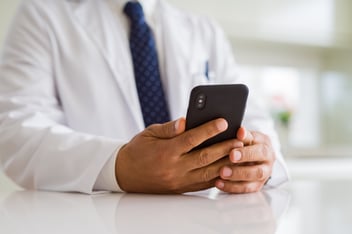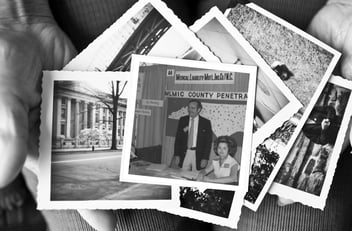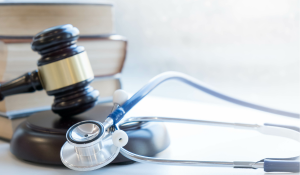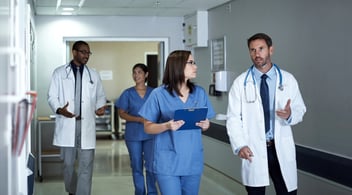You’ve been pitched a service that records audio from patient clinical visits. Should you consider it?

Jason Newton covers the pros, risks, and risk management strategies for digitally recording and sharing audio of clinical exam visits as well as his recommended precautions.
Patients have been recording clinical exam visits for years, often without the clinician's permission or awareness. When I was in private law practice over a decade ago, one of the malpractice cases I defended involved a patient who tucked an old-fashioned Dictaphone into her bra to secretly record a physician who was communicating an apology. The plaintiff's counsel obtained a copy, got it transcribed, and it became evidence that the jury would see and hear.
Now, in an era where technology seamlessly integrates into our daily lives and a smartphone "recording device" is in everyone’s pocket, one innovation is gaining traction: services that allow clinicians to digitally record and share audio of their clinical exam visits with their patients. While promising several benefits, this technology also comes with risks. Ten years ago, if I had been asked about this technology, I would certainly have been against it. Today, I am open to it, but in certain situations and with precautions and an appreciation of the risks.
Benefits
Improved Patient Understanding and Recall: One of the most significant potential benefits of recording clinical visits is enhancing patient understanding and recall. Medical consultations often involve complex information and instructions that can be overwhelming to process in real-time. A recording allows patients to revisit the conversation, ensuring they fully grasp the details and follow through with the recommended treatment.
Enhanced Family Involvement: Recordings can be shared with family members who play a critical role in the patient's care. This could be especially beneficial when dealing with elderly patients or those with cognitive impairments. Family members can listen to the recording, helping them support the patient better by understanding the medical advice and instructions.
Increased Transparency and Trust: Recordings can foster a sense of trust between the patient, family, and healthcare clinician. It demonstrates a willingness on the clinician’s part to be open and transparent. I found this to be the case in my own experience when I accompanied my father, who was being treated for a serious medical condition by one of the world’s leading experts at a large, well-known medical center. The fact that the physician let me record the visit increased my bond with and respect for this physician during an emotionally difficult period.
Legal Protection: In cases of misunderstandings or disputes, having a recording of the visit may serve as an objective reference. If anyone is going to make a recording, and we expect that patients might or do, why not create, and have one that ensures good audio quality and provides an unedited record of what happened? This can protect the patient and the clinician by ensuring the patient understands what happened during the encounter, potentially reducing the risk of malpractice claims based on miscommunication.
Risks
Impact on Physician-Patient Relationship: Knowing they are being recorded might make some clinicians feel scrutinized, potentially altering their communication style and behavior. Additionally, some clinicians may not excel at bedside manner or communication skills, and even the best communicators might come off as less than friendly on a hectic and stressful day.
Privacy Concerns: Digital recordings of clinical visits raise significant privacy issues. Creating recordings necessarily involves that they could be accidentally shared or accessed by unauthorized individuals, potentially exposing sensitive personal health information.
Liability Complications: Should the fact that a recording was made be documented in the patient record? What happens when the recording contradicts or is arguably inconsistent with what the clinician documented? Years ago, medical records were viewed as the most accurate and contemporaneous documentation of what was said and done during a clinical visit; that is no longer true with digital recordings in the mix. The recording is proof of all that was or was not said. Interestingly, researchers in a recent study found that the audio-video recording of clinic visits was not associated with increased malpractice claims or litigation.[1]
Legal Evidentiary Challenges: Who owns the digital recording? Managing and storing recordings securely can be technically challenging. Can the recording be produced years later as evidence, if necessary? What about detecting if/when a digital recording has been altered? How will digital recordings be authenticated in court? Federal judiciary officials are now exploring how to handle evidence faked by artificial intelligence or editing tools and the need to change evidentiary rules.[2]
Risk Management Strategies
Digitally recording clinical exam visits offers a blend of benefits and risks. Recommended precautions include:
- Take a slow and measured approach. Start with a trial period allowing visit recordings with a pilot group of clinicians and appropriately selected patients. Confident clinicians and certain patients are better suited to this technology, and it may not be for everyone, even long term. The most crucial thing in defending a medical malpractice lawsuit is the impression the clinician makes on the jury. Ideally, the defendant clinician is someone jurors would want to treat their mothers. Much time goes into prepping a clinician for trial testimony. The audio recording will be played during the trial. Will your clinician be given the equivalent of an A+ trial testimony performance on any given Monday?
- Develop a written policy designating when/why a digital recording of an exam visit may occur. Outline obtaining and documenting the clinician's and patient's consent, how recordings will be stored, by whom, how long they will be retained, who has access and owns the recording, and destruction of digital materials.
- Identify/clarify what recording devices are allowed. Only clinic-approved devices where the clinician also retains a copy of any app or device the patient wants to use?
- Do your due diligence with vendors providing this service. Examine the vendor's terms of service. Determine where the recording will be stored and for how long. What if you end your relationship with the vendor? How do you access data, and for how long? If your practice made a recording, the jury may be instructed that your inability to produce it years later should be considered proof that the recording contained information harmful to your defense. What about the vendor's cybersecurity? How confident are you that their systems are staying secure? Pay special attention to contractual indemnification provisions in case of a vendor data security incident or breach.
As digitally recording exam visits become more prevalent, clinicians and their administrators must carefully weigh the benefits and risks and establish clear policies and safeguards to protect patients, clinicians, and their organizations.
Contact Curi for help navigating innovative technologies and emerging risks impacting clinicians and their practices.
References
[1] Naeem K, Bhargava M, Porter RW. Medico-Legal Implications of Video Recordings of Clinic Visits in Malpractice Claims Against Medical Providers. Cureus. 2024 Feb 5;16(2):e53627. Accessed May 29, 2024.
[2] Deepfake Rule Proposals Navigate 'Perfect Evidentiary Storm.' Accessed May 28, 2024. https://www.law360.com/pulse/articles/1837826#
About the Author

Jason is a Senior Fellow in the Litigation Counsel of America and since 2019 has been selected to serve on five editorial advisory boards of the go-to national daily online legal publication Law360.
He has authored or contributed to over 35 publications. Jason is a nationally recognized and frequently sought-after speaker, and organizations coast to coast regularly ask Jason to speak on a variety of topics relevant to physicians around the country. He has given over 150 presentations to more than 12,000 healthcare providers, lawyers, and medical liability industry professionals.
Jason has a BA in Political Science from the University of North Carolina at Chapel Hill and a JD from Wake Forest University School of Law.








Comments